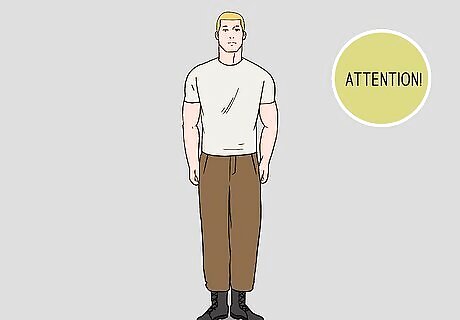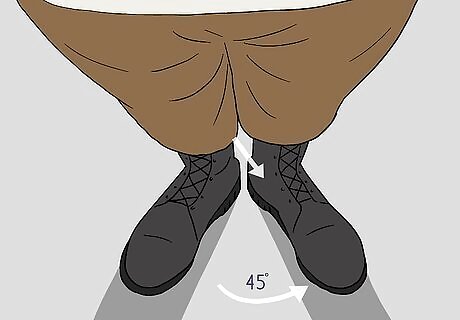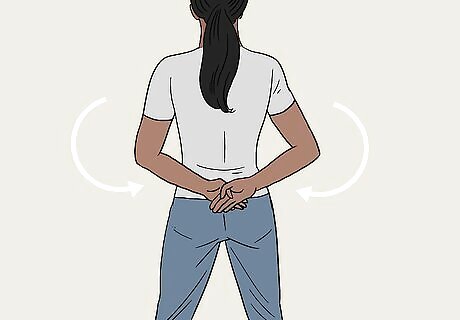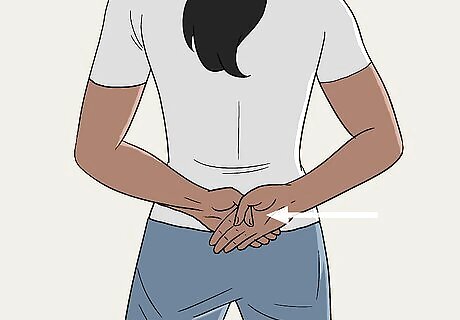
views
Starting at Attention

Stand at attention when given the command by an officer. Attention is the base stance for all stationary movement in the military. You will never be told to stand at ease without being told to stand at attention first. When an officer enters the room, you will hear the command, “Attention.” This is a signal to assume the stance of attention. You must also assume this stance if you hear “fall in,” or “squad/platoon, attention.” You must automatically assume the stance of attention when an officer passes you by. If you take too long to assume the proper stance or fail to do it correctly, you may be in some serious trouble with your commanding officer.

Move your left foot to bring your heels together at a 45-degree angle. Stand up if you are seated. Lift your left foot up and bring your heels together so that they’re directly underneath your spine. With your heels together, angle both of your feet away from you so that your feet form a 45-degree angle. Bring your spine to wherever your right foot is located. You are not supposed to move your right foot to stand at attention. Only the left foot can shift to get into the proper stance.

Stick your chest out 3–5 in (7.6–12.7 cm) and straighten your spine. With your heels underneath you, puff your chest out a little and stand up straight. Do not move your head or your eyes as you do this. Keep your chin up and your eyes facing forward. Do your best to not sway or move left or right. This will make you seem like you’re leaning as you’re getting into the stance. Your frame must be completely erect, and you should embody a sense of confidence and strength.

Hang your arms at your sides with your thumbs against your seams. Relax your arms. Allow your arms to hang at your sides with your fingers curled into your palm. Place your thumbs directly on the seams of your pants, facing downwards. Your arms don’t need to be completely stiff, but they do need to hug your sides as they hang down. This entire motion should take 1-2 seconds. Your elbows can be bent slightly so long as your thumbs are hugging the seams on your pants.

Keep your eyes facing forward and don’t move your head. In attention, it is essential that you don’t turn your neck, move your eyes, or adjust your head. Face forward with your eyes still and don’t turn to look at whoever is speaking in some other part of the room. Do not tilt your head, yawn, open your mouth, or make a face. It helps to focus your eyes on some object in front of you and stare at that until you’re given the command to stand at ease. You may be given the order to stand at “parade rest” before you are given the command to stand at ease. Parade rest is an uncommon stance that is a combination of attention and at ease, although some branches of the military don’t use it.
Standing at Ease

Shift to at ease from attention when given the command. From the stance of attention, listen for the call to stand “at ease.” This is an indicator that you can relax a little, and the commanding officer is likely to begin speaking. Once you hear the call to stand at ease, you can relax a little and move your head. Don’t break silence and don’t make any sudden movements, though. In some stationary drill handbooks, the order of “at ease” is automatically assumed when an outranking officer enters the room and is introduced.

Move your left foot 1–2 ft (0.30–0.61 m) to the left. Shift your left foot to your left so that it sits directly underneath your left shoulder. Keep your feet pointed outwards at a slight angle and bend your knees so that you’re comfortable. You should be able to stand at ease for hours at a time. Don’t lock your knees up so that blood can reach your feet and you don’t get lightheaded. Keep standing up straight, even if you’re bending your knees a little.

Relax your frame and move your arms behind your back. Allow your chest to shift to a comfortable position. Calmly move both of your arms behind your back. Bring them to the small of your back, above your belt. Do this at the same time that you’re moving your left foot. This entire motion should take less than 2-3 seconds.

Interlace your thumbs and keep your hands together. Place the back of your left hand directly against your back with your fingers together but your palm open. Lay your right hand on top of your left and interlock your thumbs. Your hands should form an X in the small of your back. The thumbs are the only fingers that interlock. Your other fingers should remain together and straight. Let your elbows bend in a way that’s comfortable while you’re doing this.

Remain at ease until you’ve been given another command. Feel free to look at the officer addressing you when you’re standing at ease, but don’t glance about the room or speak. Maintain silence and stand comfortably until you’re given another command. Most of the time, the following command will be “carry on,” since almost every other position is called from attention. If you’re told to “carry on,” go back to whatever you were doing before the commanding officer entered the room.



















Comments
0 comment